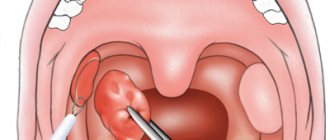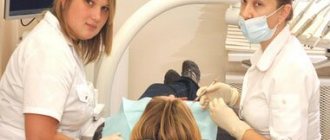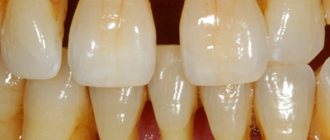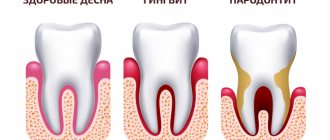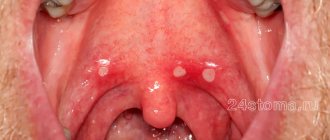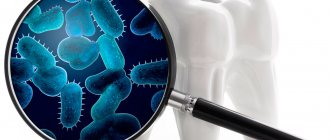Periodontal disease is a fairly rare disease of non-inflammatory origin, characterized by systemic damage to the periodontal tissues (periodontium), which is often difficult to diagnose in the early stages. Its appearance, as a rule, is associated with a hereditary predisposition or systemic diseases of certain organs.
There is often an erroneous spelling of this term - periodontal disease. In order to dispel all doubts, let us turn to the etymology, which covers two words in ancient Greek: πᾰρά (para - “near, located near”) and ὀδόντος (odóntos is the genitive case of the word ὀδούς - odus, translated means “tooth”).
Consequently, from the ancient Greek language this term is translated as “near the tooth” or “located next to the tooth.”
There are cases when even doctors mistakenly call periodontal disease a completely different disease - periodontitis, which is in fact a completely different phenomenon due not only to its inflammatory origin, but also to other features.
How does periodontal disease occur?
Periodontal disease is a systemic disease of the periodontal tissue, or periodontium. Refers to inflammatory gum diseases.
The causes of periodontal disease are pathogenic microbes living in dental plaque, under the influence of which inflammation occurs. That is, in fact, the main reason for the occurrence is insufficient oral hygiene and the constant presence of dental plaque.
Periodontal disease at the initial stage is confused with gingivitis or periodontitis.
The insidiousness of the disease is that the patient does not even suspect its presence for a long time. The gums become sensitive and begin to bleed, but all these symptoms develop over a long period of time and gradually, so from the moment of onset until the moment when the patient begins to understand that there is something wrong with the gums, time passes and the favorable moment for treatment is missed.
If periodontal disease treatment is not started in time, a periodontal pocket forms at the root of the tooth, in which pathogenic bacteria multiply and cause destruction and resorption of the root.
What is periodontitis? Causes and symptoms
With contagious periodontitis, the periodontal structures become inflamed, the periodontal junction is destroyed, and periodontal pockets are formed. Pathogenic bacteria accumulate in them.
The reasons for the development of an infectious condition are the accumulation of dental plaque, contagious gingivitis, and improper or insufficient oral hygiene. The contagious disease itself is infectious in nature.
Symptoms of periodontitis:
- redness and bleeding of the gums;
- bad breath;
- exposure of the necks of the teeth;
- loose teeth.
Is the disease contagious? Is periodontitis transmitted through kissing?
Periodontitis is infectious in nature because it is caused by pathogenic microorganisms. May accompany periodontal disease.
When kissing, the pathogen is transmitted, and there is a risk of infection and the development of periodontitis.
Causes
- hereditary factor;
- the presence of a large number of pathogenic microbes;
- malocclusion;
- injuries to teeth and gums;
- the presence of common diseases, for example, diabetes, hypertension, atherosclerosis and some other diseases.
With periodontal disease, the nutrition of periodontal tissue is disrupted, resulting in changes in the structure of the gum tissue. All the causes that contribute to the occurrence of periodontal disease can be divided into two groups:
- Group 1 - general reasons;
- Group 2 - local causes.
The common causes of periodontal disease are directly related to the patient’s health status and depend on the patient’s presence of diseases of the endocrine system, cardiovascular system, gastrointestinal tract, and hypovitaminosis.
Local causes are local in nature, they depend on
- correct bite;
- development of the vestibule of the oral cavity;
- correspondence of the sizes of the frenulum of the tongue and lips;
- the presence of tartar and the intensity of dental plaque, in which pathogenic bacteria and microorganisms actively multiply.
Microbes provoke the development of an inflammatory process in the gum tissue, as a result of which the gum tissue becomes loose and gradually collapses. Microbes develop most actively in plaque and tartar, so with careful oral hygiene, the risk of developing periodontal disease is significantly reduced.
Heredity. If parents had periodontal disease, their children will most likely have a tendency to this disease, especially if pathologies of the body are discovered - chronic diseases of internal organs, diabetes, problems with the endocrine system, in particular the thyroid gland, diseases of the cardiovascular system.
Are there any risk factors?
If you have diabetes, atherosclerosis, osteoporosis or rheumatism, then periodontal disease may appear due to impaired blood supply to tissues. Taking a blood glucose test will help identify predisposition to the disease.
Another cause for concern is age-related and hereditary changes. Unfortunately, in most patients after age 70, the gum tissue thins, exposing some of the teeth.
Those at risk are those who neglect an annual examination by a specialist. The main treatment for periodontal disease is to stop it and preserve as many teeth as possible. Damaged gums do not come back.
A lack of vitamins in the body can worsen the course of the disease. It is necessary to take prescribed vitamin complexes or balance your diet. It is worth consuming the following vitamins, especially at the initial stage of the disease:
- A – regenerates dentin;
- group B – improves tissue nutrition, improves mineral metabolism;
- E – triggers oxidative reactions, has a positive effect on capillaries;
- C – helps relieve or prevent inflammation, reduces bleeding, is especially effective when taken with rutin (vitamin P);
- K – improves blood clotting.
It is worth giving your teeth adequate stress, this is facilitated by eating fresh vegetables and fruits. For treatment, antibiotics are prescribed, massages and herbal medicine are prescribed. It is worth paying attention to gingivitis - inflammation of the gums is a reason for close monitoring of the condition of the oral cavity. If you ignore gum inflammation, then poor hygiene creates ideal conditions for the formation of pockets and the development of pathogenic microflora there.
During pregnancy, it is worth visiting your dentist for hygiene recommendations and to identify gum problems. With gestosis (the appearance of edema), the likelihood of periodontal disease increases due to disruption of cytokines in saliva.
Diagnostics
Only an experienced dentist can diagnose periodontal disease, since at an early stage the symptoms are similar to those of other diseases, so it is extremely important to make a correct differential diagnosis from other diseases with similar symptoms.
When making a diagnosis, the doctor must examine the patient, carefully ask him about symptoms, well-being, and the presence of diseases, especially systemic problems with the endocrine system. You should also indicate the degree of development of periodontal disease, the depth of the gum pockets, the type of atrophy, and the degree of exposure of the necks of the teeth. All this will help to correctly identify the causes and prescribe treatment.
When diagnosing periodontal disease, a variety of functional diagnostic methods are used. With their help, it is possible to detect initial vascular changes, which makes it possible to make a diagnosis at an early stage.
- Using the modern method of rheoparodontography, it is possible to diagnose the early stage of development even in young people, when symptoms practically do not appear.
- Using the polarography method, it is possible to detect even a slight decrease in the level of oxygen in the gum tissue.
- It is impossible to make a correct diagnosis without modern X-ray examination. It is the radiograph that allows us to determine the degree of atrophy of the alveolar process, which allows us to correctly determine the stage of development.
- With periodontal disease, ROE increases, as there is constant intoxication of the entire body with decay products and vital activity of pathogenic microorganisms. The leukocyte count shifts to the left, the patient may complain of low-grade fever for a long time. Therefore, when making a diagnosis, it is also important to order a general blood test of the patient.
It should be noted that periodontal disease is a disease that lasts for years. And sometimes years pass from the appearance of the first symptom to a visit to the dentist. Therefore, doctors are often faced with advanced conditions of teeth and gums. With careful oral hygiene and following all the recommendations and instructions of the dentist, it is possible to keep teeth and gums healthy into old age.
Signs of disease development
In the early stages, periodontal disease is usually asymptomatic in humans. It is accompanied only by a slight change in the color of the gums. Painful sensations and any other manifestations are not inherent in it, which is why patients in the first months of the development of the pathology do not pay attention to it and do not come to the doctor in a timely manner.
As a rule, the disease makes itself felt only 3-5 years after the onset of the pathological process.
In the later stages, the development of periodontal disease in a person can be recognized by a number of characteristic symptoms. These include:
- Change in gum color. With periodontal disease they become pale. Inflammatory processes, suppuration, and bleeding are rarely observed with this disease.
- Reduction of alveolar processes in size. This symptom leads to exposure of the neck of the tooth. At the same time, the teeth themselves do not become loose and remain firmly in place.
- Itching that periodically occurs on the gums.
- Minimum amount of plaque and tartar on the teeth. In some cases, they may be completely absent in patients.
Also, with periodontal disease, a person may experience non-carious lesions of tooth tissue. These include abrasion of enamel, erosion, and wedge-shaped defect. Such pathologies require additional diagnostics and usually indicate the presence of concomitant diseases in the body, including pathologies of metabolic processes.
In the later stages of the disease, the patient may experience inflammation of the gums, tooth loss and the formation of ulcers. As a rule, at least 15-20 years pass between the onset of pathology and this stage.
Pain due to periodontal disease
With periodontal disease, patients may experience pain. The reason for its appearance is the exposure of the necks of the teeth. Because of this, their sensitivity to cold and hot foods increases. When contacting such products, an acute short-term pain usually appears, which disappears after the end of exposure to the irritant on the neck of the tooth.
With periodontal disease, patients do not have gum pain. If this symptom is present, there may be some additional damage (for example, cuts to the gums) or other diseases that complicate the underlying disease. If such symptoms appear, you should consult a doctor for additional advice.
Treatment
In the treatment of periodontal disease, the following modern treatment methods are used:
- Surgical.
- Orthopedic.
- Physiotherapeutic.
- Therapeutic.
The best treatment results are achieved when treatment is carried out comprehensively, using all of the above treatment methods.
- The surgical method is effective when there is a high degree of atrophy of the alveolar process. In this case, bone tissue is surgically built up, which helps keep the teeth in the right place, preventing them from becoming loose and falling out. The surgical method is also effective in the fight against periodontal (gingival) pockets.
- The orthopedic method is used when it is necessary to replace lost teeth or strengthen the fixation of those teeth that still remain. The dentist installs special crowns, bridges or dentures in the patient’s mouth.
- The physiotherapeutic method includes laser therapy and laser photophoresis. With their help, it is possible to activate blood circulation in the gum tissues and also effectively fight microbes.
- The use of therapeutic methods makes it possible to remove dental plaque and treat caries, which is an invariable companion to periodontal disease.
Additional effective methods:
- In parallel with all of the above treatment methods, the dentist must prescribe vitamin therapy , since the lack of certain vitamins and microelements in the body only intensifies the symptoms of periodontal disease. Sometimes it becomes necessary to prescribe hormonal drugs if the disease is caused by disturbances in the functioning of the endocrine system.
- During treatment, it is very important not only to adhere to the treatment regimen prescribed by the doctor, but also to use the right products for personal oral hygiene. You should brush your teeth and gums with special toothpastes developed by specialists for the treatment of periodontal disease. The presence of special ingredients in such medicinal toothpaste allows you to actively combat increased gum bleeding and inflammation. The presence of antibacterial components in toothpaste allows you to reduce the number of pathogenic bacteria in the oral cavity.
- In difficult cases, the doctor may recommend a patch operation, during which the formed inflammatory granulations and dental plaque are removed, and the cavity is treated with special antibacterial agents.
- Treatment of periodontal disease must necessarily include dental treatment, since the presence of chipped teeth, unsuitable fillings, and poor-quality dental crowns can lead to gum injury. Therefore, the doctor must eliminate all these so-called local factors at the initial stage of treatment.
- For more effective treatment, it is also necessary to increase the body’s protective functions, which leads to the prescription of restorative and anti-inflammatory drugs.
- Traditional methods of combating periodontal disease, aimed at strengthening the gums and relieving inflammation, are also quite effective. An experienced doctor will definitely advise the patient on additional traditional methods of treatment, which do not replace full treatment, but perfectly complement it.
Consequences and complications
With periodontal disease, you can not only lose all your teeth, but also develop a bunch of other related diseases. As a rule, all patients with this disease suffer from diseases of the gastrointestinal tract, since the absence of teeth or severe chronic inflammation of the gums does not allow them to fully chew food, which negatively affects the health of the stomach and intestines. Therefore, you should not take this disease lightly.
Without proper treatment, periodontal disease can develop into periodontitis, and this disease is even more dangerous. The course may also be complicated by the development of ulcerative gingivitis, inflammation of the lymph nodes, the appearance of gingival abscesses, and the occurrence of osteomyelitis of the jaw.
Treatment of periodontitis at the JSC Meditsina clinic in Moscow
The clinic of JSC "Medicine" invites patients with signs of periodontitis and other gum diseases to be examined and treated. Our own diagnostic center with modern equipment allows you to undergo a full course of examinations and outline effective ways to treat the problem and its consequences. Each patient is guaranteed confidentiality of personal information, absence of pain and discomfort during dental treatment, as well as the opportunity to undergo all planned procedures at the center. Call to make an appointment and get additional advice on issues of interest. Registration for the clinic is also available on the website 24/7.
Prevention
Doctors always warn: prevention is much more effective than subsequent treatment. Therefore, it is much more important to prevent the development of periodontal disease, because treatment can last a very, very long time.
The main preventive measures include careful oral hygiene. It is necessary to thoroughly brush your teeth twice a day with a special toothpaste, and also use rinses that help strengthen your gums and protect them from inflammation. It is also necessary to adhere to the principles of a healthy diet and limit the consumption of sweets.
Is periodontal disease contagious?
Many patients, having heard enough horror stories that periodontal disease is contagious, ask how it is transmitted, whether it is possible to become infected through dishes, through kissing, and whether the disease is transmitted by airborne droplets. Let us reassure you right away: in itself it is not contagious, however, you can always catch pathogenic bacteria that contribute to its development. However, this does not mean at all that you should give up kissing; it is only important to adhere to the rules of oral hygiene. And then you won’t be afraid of periodontal disease.
